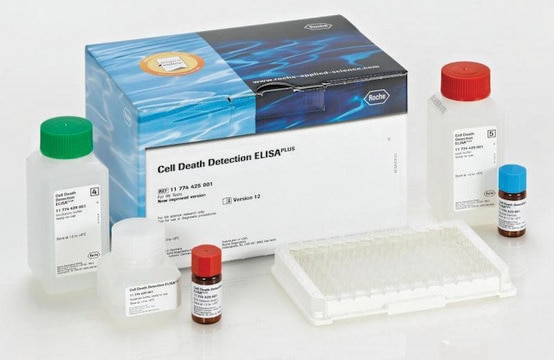12156792910
Roche
In Situ Cell Death Detection Kit, TMR red
sufficient for ≤50 tests
Synonym(s):
red, tm, in situ cell death detection kit, tm red, in situ cell death detection kit
About This Item
Recommended Products
usage
sufficient for ≤50 tests
Quality Level
manufacturer/tradename
Roche
technique(s)
flow cytometry: suitable
storage temp.
−20°C
Related Categories
General description
The hallmark of apoptosis is DNA degradation, which in early stages, is selective to the internucleosomal DNA linker regions. The DNA cleavage may yield double-stranded and single-stranded DNA breaks (nicks). Both types of breaks can be detected by labeling the free 3′-OH termini with modified nucleotides (e.g., biotin-dUTP, DIG-dUTP, fluorescein-dUTP) in an enzymatic reaction. The enzyme terminal deoxynucleotidyl transferase (TdT) catalyzes the template-independent polymerization of deoxyribonucleotides to the 3′-end of single- and double-stranded DNA. This method has also been termed TUNEL (TdT-mediated dUTP-X nick end labeling). Alternatively, free 3′-OH groups may be labeled using DNA polymerases by the template-dependent mechanism called nick translation. However, the TUNEL method is considered to be more sensitive and faster.
Sample material: Cells in suspension, cytospin and cell smear preparations, adherent cells grown on slides, and frozen and paraffin-embedded tissue sections.
Principle
The In Situ Cell Death Detection Kit, TMR red is based on the detection of single- and double-stranded DNA breaks that occur at the early stages of apoptosis.
Apoptotic cells are fixed and permeabilized. Subsequently, the cells are incubated with the TUNEL reaction mixture that contains TdT and TMR-dUTP. During this incubation period, TdT catalyzes the addition of TMR-dUTP at free 3′-OH groups in single- and double-stranded DNA. After washing, the label incorporated at the damaged sites of the DNA is visualized by flow cytometry and/or fluorescence microscopy.
Specificity
Application
Packaging
Preparation Note
The optimal enzyme concentration range from 0.5 to 5 U per assay. For a standard 50 μl PCR, we recommend using 2 U of the enzyme blend.
Working solution: Add total volume (50 μl) of Enzyme Solution to the remaining 450 μl Label Solution to obtain 500 μl TUNEL reaction mixture.
Mix well to equilibrate components.
Storage conditions (working solution): The TUNEL reaction mixture should be prepared immediately before use and should not be stored. Keep TUNEL reaction mixture on ice until use.
Kit Components Only
- Enzyme Solution (TdT)
- Label Solution (TMR-dUTP)
Signal Word
Danger
Hazard Statements
Precautionary Statements
Hazard Classifications
Aquatic Chronic 2 - Carc. 1B Inhalation
Storage Class Code
6.1D - Non-combustible acute toxic Cat.3 / toxic hazardous materials or hazardous materials causing chronic effects
WGK
WGK 3
Flash Point(F)
does not flash
Flash Point(C)
does not flash
Certificates of Analysis (COA)
Search for Certificates of Analysis (COA) by entering the products Lot/Batch Number. Lot and Batch Numbers can be found on a product’s label following the words ‘Lot’ or ‘Batch’.
Already Own This Product?
Find documentation for the products that you have recently purchased in the Document Library.
Customers Also Viewed
Articles
Cellular apoptosis assays to detect programmed cell death using Annexin V, Caspase and TUNEL DNA fragmentation assays.
Related Content
In Situ Cell Death Detection Kit TMR red Protocol
Our team of scientists has experience in all areas of research including Life Science, Material Science, Chemical Synthesis, Chromatography, Analytical and many others.
Contact Technical Service










